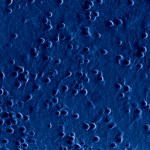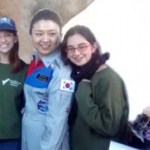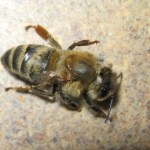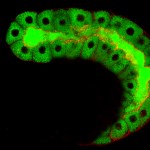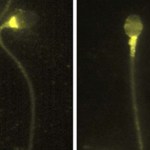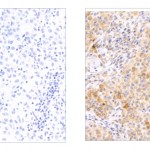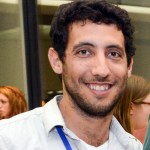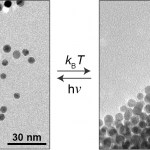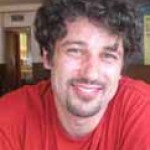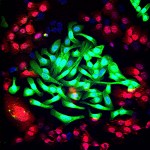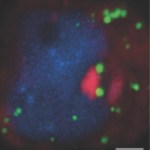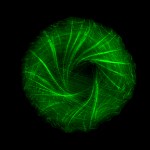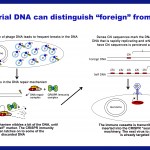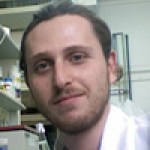Does the brain really operate like some kind of extra-complex computer, with logic gates and circuits made of the synapses that connect one neuron to another?
In 2009, we wrote:
In the future, the interface between brain and artificial system might be based on nerve cells grown for that purpose. In research that was recently featured on the cover of Nature Physics, Prof. Elisha Moses of the Physics of Complex Systems Department and his former research students Drs. Ofer Feinerman and Assaf Rotem have taken the first step in this direction by creating circuits and logic gates made of live…

Is this science writer jazzed that ninth-grade girls from a religious girls’ school in Jerusalem won a space/science contest? You bet your sweet solar-powered spacelab she is! It is not just that these girls beat out a lot of other classes (over 400), or that they break more than one stereotype. They also came up with a pretty clever idea for studying the Sun: Send a spacecraft to scatter assorted nanolabs all over an asteroid that is about to pass close to the Earth on its way to the Sun. The contest is held every year in memory of Israeli astronaut Ilan Ramon, who went down with the crew of…
The whisking of a rat’s whisker is a classic example of “active sensing” – in other words, sensing that involves movement. Prof. Ehud Ahissar studies rat whisking in order to understand how mammals perceive through all types of active sensing; without the continuous movement of whiskers, fingertips or eyes, our perception of our surroundings would be lacking. (If you don’t believe us, try feeling the texture of your shirt or desktop without moving your fingers. You can’t stop your eyes – as you read this, your eyes are actually moving back and forth in tiny movements.)
In the latest research…
Why does infection with bacteria or viruses make you feel sick? Prof. Guy Shakhar and Dr. Keren Shakhar have proposed that your symptoms are not just a byproduct of your body’s attempt to get rid of the infection. It is your genes’ way of ensuring they are passed down. The long and short of their argument is that the malaise, loss of appetite and lethargy are all ways of isolating you from your social group – so that your kin, who carry many of your genes, are not infected as well.
That means we share an evolutionary adaptation with such organisms as bees that go off to die far from the hive…
Cells that “spit” out their contents and messenger RNA that is not so swift at delivering its message. Those are two brand new stories on our new and improved website. Check it out and let us know what you think.
The first story arose from a simple question: How do secretory cells – those that produce copious amounts of such substances as tears, saliva or all those bodily fluids – manage to get their contents out of the cell? Cells are walled all the way around; they don’t really have doors for letting things the size of a drop of fluid out. Instead, they use the vesicle system – small globes…
The Weizmann Wave has been a bit dormant lately for various reasons, including the fact that we have been getting ready to launch our new website (same address, same content, slightly different look).
While you eagerly await the new site, here is a quiz we put on Facebook to see if anyone has been following our research news over the past year.
Also, don’t forget to check out Cell Biology by the Numbers, featuring the best picks of the BioNumbers site, edited by our own Prof. Ron Milo, together with Prof. Rob Phillips of CalTech and illustrated by Nigel Orme. Start browsing and you’ll be…
Metastatic melanoma tumors. Left exhibits low or absent expression of RASA2 and reduced survival, typical of about 35% of patients. The sample on the right exhibits high RASA2 expression and increased survival
Rates of melanoma are increasing, even as the rates of other common cancers are decreasing. According to the Melanoma Research Alliance, it is the most common cancer diagnosis in young adults 25-29 years old in the United States, the second most common cancer in young people 15-29, and its incidence has tripled in the last 30 years.
What are we doing about it? The Weizmann Institute’…
Our researchers often appear in the pages of Nature, Science, etc, but here is one we think is worth mentioning: Christoph A. Thaiss, a PhD student in the immunology group of Dr. Eran Elinav, recently appeared in Nature – as an interviewer of Bruce Beutler, who shared one half of the 2011 Nobel Prize in Physiology or Medicine with Jules Hoffmann for their work on the activation of innate immunity. Thaiss and Beutler were at the Lindau meetings, where young researchers get to rub shoulders with Nobel laureates. Beutler, whose work has been called the second revolution in immunology says that…
Ziv Zwighaft
Ziv Zwighaft is a research student in the group of the Weizmann Institute’s Dr. Gad Asher. Their new findings reveal some intriguing connections between our circadian clocks – which tick according to cycles of day and night – metabolism and aging. Here is his description:
King Solomon said: “There is a time for everything, and a season for every activity under the heavens.”
Our research tries to take this insight into the condition of living creatures a few strides forward. How strictly does it apply? Our lives are regulated by a biological clock – it’s actually many clocks…
One day in the future, we may be treating our ailments with microbiotic combinations designed specifically to correct imbalances in our personal microbiomes. We’ll bring our prescriptions on rewritable paper and pay using shimmery optical chips embedded in our cell phone cases or maybe our jewelry. Or we’ll be waiting in our doctor’s office for a simple test of our microbiogenome to see if a light-based nanoparticle delivery treatment is working, while watching iridescent optical displays that change as we move...
These future scenarios (and many more) are all imaginary, but they are…
It is a mystery no more: A physical model can explain how a bunch of ants are able, with no visible leader (or highly-developed brains, for that matter) to drag that oversized cake crumb or leaf all the way across your floor to their nest. It turns out that there are, indeed, leaders, of a sort. Those ants you see surrounding the prize being hauled are switching places with other ants that have been scouting out the directions to the nest. The new ants then direct the collective movement, at least for a moment or so until they begin to lose their sense of direction and newer ants take over.…
This year's CWTS Leiden Ranking put the Weizmann Institute at number 10 -- and number one outside of the US -- for impact.
What is impact? In dry terms, it is publications in excellent journals and citations, weighted for institute size and evaluated by subject. This prestigious ranking favors the Weizmann Institute, because it compares institutes and universities solely on the basis of published research.
So you can measure impact and give it a rank. But that number is, ultimately a proxy for something a bit more abstract: We really think of it as the part our scientists play in advancing…
When Dr. Jakub Abramson was a 14-year-old boy in the former Czechoslovakia, he asked his father what was the best place to do science. His father took the question seriously and, after some consideration, answered “the Weizmann Institute of
Dr. Jakub Abramson
Science.” Since that day, says Abramson, he knew he was bound for the Institute. “It’s just that the science I was interested in back then involved blowing things up,” he says.
Today, Abramson is more interested in exploding the common wisdom about autoimmune diseases. His lab at the Weizmann Institute has produced two new papers –…
What is a breakthrough in cancer research? It is a new piece of a puzzle made up of a million pieces. It may, however, be a piece that allows a picture to start emerging – one that lets us see the shape of the next piece needed to fill in more of the puzzle, or start making changes to rearrange the picture from one of cancerous growth to one of normalcy.
The Institute’s Prof. Yosef Yarden’s recent research provides a vital piece for the puzzle of resistance – how cancer cells, especially those in recurring cancers, stop responding to chemotherapy. His answer is specific to a kind of lung…
A few days ago, the heads of several Israeli academic institutes, including Weizmann Institute of Science President Prof. Daniel Zajfman, met with Israel’s president, Reuben Rivlin to discuss the possible effects of an academic boycott. Afterward, Prof. Zajfman was interviewed on the evening magazine program London and Kirschenbaum.
For Hebrew speakers, here is the interview:
[embed]https://www.youtube.com/watch?v=SKWdbQITj28&feature=youtu.be[/embed]
For those who do not understand Hebrew, here are the main points:
It is dangerous to mix politics with scientific research. That is a…
“Inclusion bodies – those clumps of protein that are found in the brain cells of Alzheimer’s patients – are, sadly, a product of aging,” says Dr. Maya Schuldiner. “They can form naturally in practically all cells, but when these cells get old, the mechanism for clearing them away starts to fail.”
That is not great news for those of us who are already seeing signs of incipient dementia every time we forget a name or misplace our keys. But of course there is good news too. Schuldiner has discovered a “detergent” that cells make to wash away those nasty protein clumps. And she believes that, in…
Here is today's scientific image:
This delicate, fluffy object is a cytoskeleton viewed under a fluorescence confocal microscope. Below is a time-lape video of the process. For an explanation of why the cell's actin fibers twist around into this shape, go to our website.
[embed]https://www.youtube.com/watch?v=iLm0Ojngjc4[/embed]
Indeed, all three of today's new articles involve crucial cellular dynamics: cutting up unfolded proteins with pared-down molecular "scissors" and binding to metal ions in proteins. In other words, within that lovely shell-like cytoskeleton, the cell is quite a busy…
Next week is a big week for science in Israel. Tuesday is National Science Day, and Thursday is the annual Science on Tap talks in the bars and restaurants of Tel Aviv. Don't know about National Science Day -- this science writer will just point out that of all the minstries that are being fought over tooth and nail in our new government, the Ministry of Science does not even appear the list.
Science on Tap, however, is gearing up with the splash it deserves. Here is the main drag outside the huge Azrieli complex:
So if you're in or around Tel Aviv next week, check it out. All the talks…
Foreigner or native-born? Your immune system discriminates between them, as do those of bacteria. Yes indeed, bacteria do have immune systems – pretty complex ones at that. And like any useful immune system, the bacterial ones must have a good technique for distinguishing “foreign” from “self.”
You may even have heard of the bacterial immune system: It’s called CRISPR, and it’s used in biology research around the world for DNA engineering and genome editing. CRISPR normally inserts short DNA sequences taken from phages – viruses that invade bacteria – into special slots called spacers within…
Dr. Gabriele D'Uva is finishing up his postdoctoral research at the Weizmann Institute. Here is his account of three years of highly successful research on regenerating heart cells after injury. Among other things, it is the story of the way that different ideas from vastly different research areas can, over the dinner table or in casual conversation, provide the inspiration for outstanding research:
Three years ago, when I joined the lab of Prof. Eldad Tzahor, the emerging field of cardiac regeneration was totally obscure to me. My scientific track at that time was mainly focused on normal…
